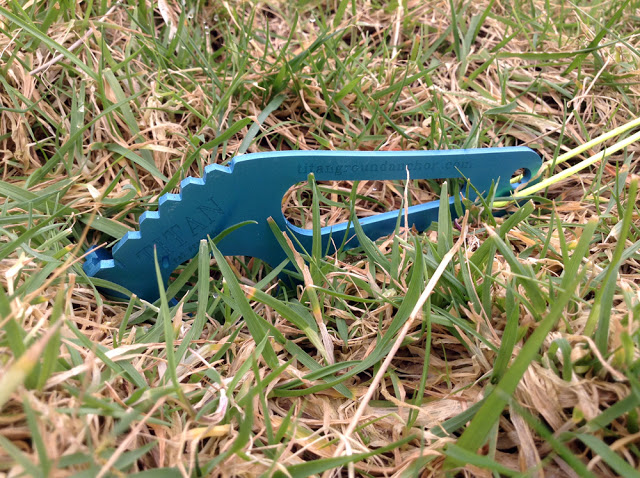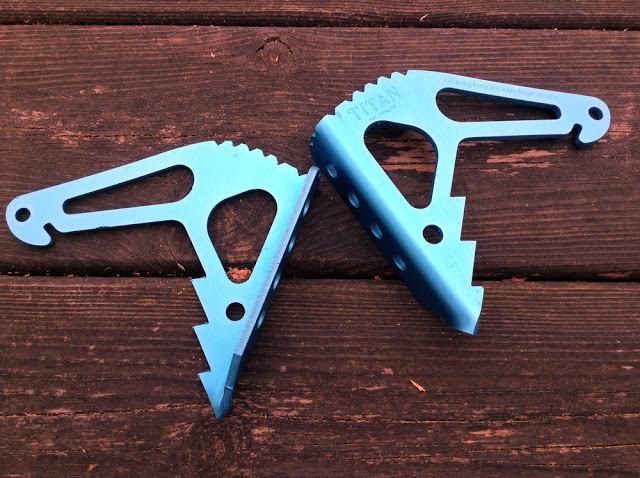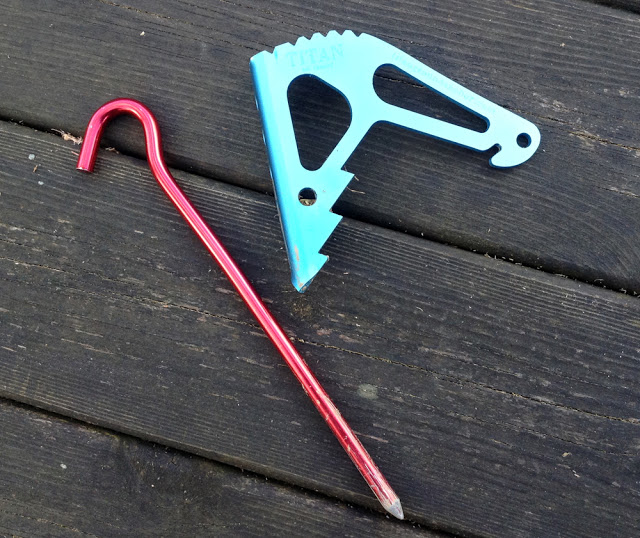To most upright members of society, a tent peg will receive less thought than what they’re having for their dinner. Conversely, to the ardent bikepacker, the seemingly humble tent peg is a source of untold fascination. Length, diameter, material and obviously weight all require careful scrutiny if the Holy Grail of tent pegs is ever to be discovered and the secrets of the universe unlocked. We all have our own ideas about what this all conquering peg would look like but how many of us have actually considered that it might not look anything like a peg at all?
 |
| Yes, you would push it in further but then, you can’t take a picture of it. |
At first sight, the ‘Titan’ tent peg looks quite unlike any other. In fact it’s referred to as a ‘ground anchor’, which given its shape, makes perfect sense. The thinking behind it is that unlike a normal peg, when a pulling force is applied to the Titan, some of that force is directed downwards helping to hold the peg in place rather than having all of it trying to tear it free of the ground.
 |
| Don’t look like your average tent peg do they? |
They’re made from aluminium (sorry Ti fans), anodised blue to make them more conspicuous and each weighs 22g according to the official Bear Bones scales. Another slightly unusual feature is that they’re designed to be pushed in with your foot rather than the more usual hand method and so feature a serrated edge which helps provide some additional grip against the sole of your shoe. Lastly, there’s also a hole at the front of the top edge for you to attach a cord to make removal easier should you wish.
My usual method of testing the effectiveness of pegs, is to place one in some suitable ground and attach a line to it. On the opposite end of this line is a scale which reads the amount of force being applied when the line is pulled – hopefully that make sense? The red peg in the picture below is what I tend to think of as a ‘standard’ tent peg. It’s made from aluminium, is 6mm in diameter and 14cm long and the kind of peg supplied by many manufacturers and used throughout the world by thousands of happy campers.
 |
| The Titan required an additional 18lb of force to pull it from the clutches of the ground. |
I carried out the highly scientific test three times on both pegs and averaged the results. The force required to pull the red peg out was 27lb. The Titan required an additional 18lb of ‘pull’ before it lost its grip with a total force of 45lb needed. I also noted that the Titan didn’t pull out cleanly and had a considerable lump of earth around it – that leads me to think that it was perhaps the soil structure that gave way first. It also makes me think that in a more compact or perhaps drier soil, the Titan’s grip would be even greater?
No single tent peg can excel in all conditions and that’s how it is with the Titan. In hard rocky ground, I found it difficult to push it deep enough for it to gain a purchase and I think the same would be true in soft deep loam – although, there’d be nothing preventing you from scraping away the soft top surface in those cases. However, in the majority of situations it appears to offer a real advantage over more traditional pegs. Personally, I wouldn’t carry one for each and every pegging point on my shelter but I would carry them for those high stress / high load points where a failure results in a total collapse. I think they’ll prove a worthy and useful addition to any tent peg collection – because we’ve all got one haven’t we?
A set of 6 costs £24 and they’re available through ebay Do note that delivery can take a few weeks.
